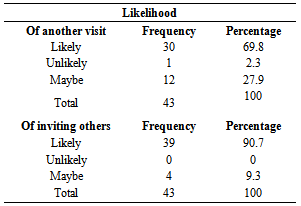-
Paper Information
- Next Paper
- Paper Submission
-
Journal Information
- About This Journal
- Editorial Board
- Current Issue
- Archive
- Author Guidelines
- Contact Us
American Journal of Tourism Management
p-ISSN: 2326-0637 e-ISSN: 2326-0645
2014; 3(1A): 1-6
doi:10.5923/s.tourism.201401.01
Investigating Indicators for Tourist Satisfaction at Mole National Park, Ghana
Folusade Catherine Arowosafe1, Adebayo Adewunmi Emmanuel2
1Department of Ecotourism and Wildlife Management, Federal University of Technology, Akure, Nigeria
2Department of Urban and Regional Planning, Federal University of Technology, Akure, Nigeria
Correspondence to: Adebayo Adewunmi Emmanuel, Department of Urban and Regional Planning, Federal University of Technology, Akure, Nigeria.
| Email: |  |
Copyright © 2012 Scientific & Academic Publishing. All Rights Reserved.
Tourist satisfaction with particular tourist attractions is manifested in various ways. At times, this is influenced by possible prior experience or lack of it. This paper reveals tourists’ level of satisfaction with visit to Mole National Park, Ghana using certain indicators. Purposive sampling of 50 tourists (42% of average tourist population for a specific period) was employed, using multiple choice questionnaires, to investigate indicators which included actual satisfaction level, likelihood of revisit, probability of inviting others to same park and reasons for possible revisit. It was discovered that the greatest percentage of tourists were young and unmarried and would be willing to repeat their visit mainly for the purpose of seeing another animal (not seen during first visit) in the park and would most likely invite others. Recommendations include provision of games which attract the youthful population and the introduction of other activities to sustain or improve tourists’ level of satisfaction with the park.
Keywords: Ecotourism, Mole National Park, Tourist satisfaction, Wildlife
Cite this paper: Folusade Catherine Arowosafe, Adebayo Adewunmi Emmanuel, Investigating Indicators for Tourist Satisfaction at Mole National Park, Ghana, American Journal of Tourism Management, Vol. 3 No. 1A, 2014, pp. 1-6. doi: 10.5923/s.tourism.201401.01.
Article Outline
1. Introduction
- Since the late 1980s, tourism has received considerable attention in the economic development strategy of Ghana. The number of tourist arrivals and amount of tourist expenditure has steadily increased, while both public and private investment activities in various tourism sub-sectors have expanded[1].Developments in international tourism and travel have increased competitiveness among overseas tourist destinations. New destinations become established, some existing ones make further progress, and others decline. Bordas[2] stated that competitiveness is established between destinations and tourism businesses rather than countries because of the different aspects and features of the destinations within a country. Travel agents also sell destinations rather than countries. As a result of increase in tourism demand for package holidays over the past two decades, destinations have also become more important than individual attractions. Therefore, tourist satisfaction with a destination, rather than with a facility, might create repeat visits. This highlights the importance of destination management in directing tourism supply and ensuring that the needs of tourists are met[3].Hector Ceballos-Lascurain has been credited with coining the word ‘ecotourism’ in 1983. Ecotourism was described as a kind of tourism which requires the implementation of environmentally responsible recreational activities within the designated natural areas, and sets forth a policy which encourages protection of the natural area with a minimal negative visitor effect and which at the same time contributes to the socio-economic development of the local population[4][5]. Ecotourism is a concept that makes contributions to the protection of natural landscape. Ecotourism is a slightly effective and small-scaled form of tourism in which there is a heightened sensitivity to the protection of the natural areas[6][7].This research investigates the satisfaction levels of tourists at Mole National Park. It probes factors directly or indirectly relating to their satisfaction level with their experience at the Park.
2. Literature Review
- Travel and tourism is one of the largest service industries in the world. When tourism is well planned, it can generate benefits at the destination by increasing tourist receipts, government revenue, and employment. For more successful tourism development, it is crucial to attract tourists and to recommend the destination for others to revisit[8]. Life satisfaction is influenced by four main components of life: leisure, health, family, and work[9]. Satisfaction with leisure, health, family, and work determines satisfaction with life; satisfaction with life directly leads to individual wellbeing. Tourism satisfaction is a key determinant of a person’s quality of life through linkages between life satisfaction and individual wellbeing. Tourism satisfaction is determined by both cognitive parameters (predetermined expectations and disconfirmation) and emotional experiences[10][11].Recent tourism marketing researches focus mainly on tourist satisfaction and perceived service quality in addition to other things such as competitiveness, attractiveness, tourist loyalty to a destination, and destination image[12] [13]. Different models have also considered satisfaction as the main determinant of revisit intention while some tourism researchers have recently focused on repeat visitation as a part of destination loyalty ([14]). Som and Badarneh[14] further refer to a comparative study by Kozak[15] studying Spain and Turkey. Results were described as different between a mature and a less-developed destination. The study used a model which proposed that the intention to revisit the same destination is linked to satisfaction level, number of past visits to the destination and number of past visits to the country. Findings equally indicated that the more mature a destination is, the more repeaters it receives. In addition to the mentioned factors in the study, maturity may include the way in which local people interact with tourists.In the study of six protected areas of the Northern Tourist Circuit of Tanzania, 86% of tourists were willing to repeat their visit and were attracted mainly to wildlife viewing but 81% equally indicated that non-wildlife attractions enhanced their tourist experience[16]. The findings of Huh[17] revealed that there is a significant difference in the overall satisfaction of tourists by gender, past experience, and decision time to travel. It was also revealed that past experience controlled the relationship between the overall satisfaction of tourists and derived factors (general tour attraction, heritage attraction, maintenance factors and cultural attraction). A study of visitors’ perception in 23 Alabama state parks shed light on the factors that are encompassed in a typical camping visitors’ satisfaction; including people, service, tangibles, and restrooms. It has demonstrated that the tangible factor (the physical facilities, equipment, and appearance of the location) plays the strongest role in both overall satisfaction and future behavioural intentions[18]. The findings of Kalisch and Klaphake[19] reveal that levels of perceived disturbance vary greatly within the two different groups of day trippers at a German National Park. The study found that 84.9 % of those who arrived as part of an organised group did not feel that the large number of other visitors that they encountered constituted a disturbance while in comparison and contrast, 68.7% of independent day trippers were of the opinion that the high number of other visitors to the island was a disturbance. This is a variation in perception of overcrowding in parks by the two sets of visitors.This paper focuses on the variables that are directly related to tourist satisfaction in Mole National Park, Ghana in order to further researches on tourist satisfaction across geographical space.
3. Methods and Materials
3.1. The Study Area
- This study was undertaken at Mole National Park in Ghana. Mole National Park is the largest and most developed protected area in Ghana for ecotourism and wildlife viewing. It is located on 9042’N and 1050’W and covers an area of 4,840km2. It was established in 1958 and designated as a national park in 1971. The park is located in northern Damongo in the northern region of Ghana on grassland savanna and riparian ecosystems at an elevation of 150m, with sharp escarpment forming the southern boundary of the park[20]. The park's entrance is reached through the nearby town of Larabanga[21]. The Lovi and Mole rivers are ephemeral rivers flowing through the park, leaving behind only drinking holes during the long dry season[22]. This area of Ghana receives over 1000mm of rainfall annually. Figure 1 shows the location of Mole National Park in the National Setting of Ghana.
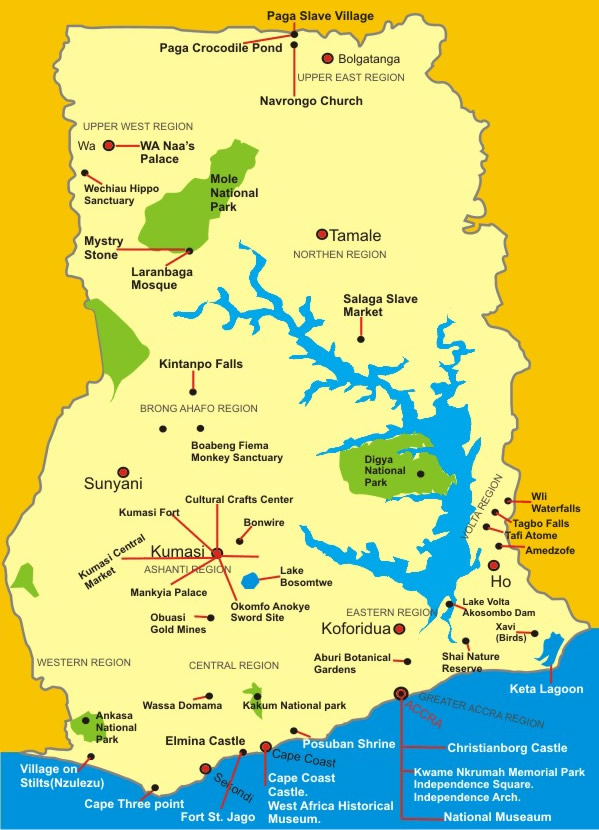 | Figure 1. Location of Mole National Park in Ghana National Setting. Source: beyondadventures.blogspot.com (2013) |
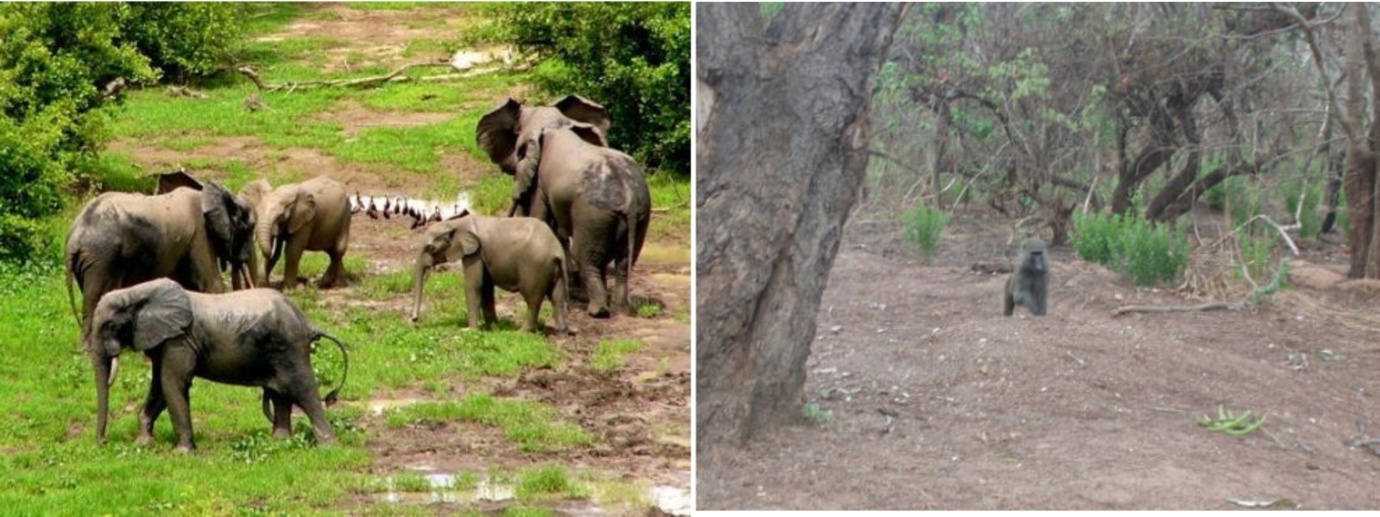 | Figure 2. Some of the Animals at Mole National Park. Source: members.virtualtourist.com & Authors’ Fieldwork, 2013 |
3.2. Sampling, Data Collection and Analysis
- Data obtained from officials of Mole Park indicated that a daily average of 40 tourists visited the park in 2012. This gives an average of 120 tourists for 3 days. The data for this research were obtained for 3 days. 50 respondents which represent 42% of a 3-day population (120) were selected for questionnaire administration. Multiple choice (close-ended) questionnaires which were face-validated by researchers in tourism were employed to gather data from respondents. Field assistants were engaged to administer questionnaires to tourists at the park motel and also during the morning and evening foot and drive safaris on 3 different days in February, 2013. Some of these questionnaires were retrieved immediately while others were returned to the reception of the motel or collected at the next safari. Of the 50 questionnaires administered, 43 were used for analysis as the remaining 7 were rendered invalid due to lack of complete information. The questions focused, among others, on indicators that reveal the level of satisfaction derived by tourists from the National Park.
4. Findings and Discussion
4.1. Socio-economic Characteristics
- Table 1 presents a breakdown of the data obtained on socio-economic characteristics of tourists at Mole National Park. More male respondents than female were discovered at the park and the greatest percentage (62.8%) of these tourists were below the age of 30. The age distribution reveals a trend indicating reduction in the number of tourists as the age bracket increases. This shows that the younger generation is more fascinated with game viewing at Mole National Park than the older one. Furthermore, education seemed to have created enlightenment and interest in prospective tourists as more than three-quarters of the visitors to Mole National Park had tertiary education while 21% out of the remaining 23.2% had secondary education. Some of the student tourists were found to be researchers in the field of tourism, recreation and wildlife while others were on organised excursion from their schools. This may explain the high percentage of tourists with tertiary education.
|
4.2. Purpose of Visit
- It was discovered that 86% of the tourists visited the park for the purpose of relaxation while 7% each were there for research and for a change of environment (see Figure 3). Scientific excursions are embarked upon by researchers in the field of wildlife study and plant science while some persons change environment due to boredom of job or locality. However, the bulk of tourists do visit sites for fun, rejuvenation, restoration and adventure. This could still be viewed in the sense of relaxation as most tourists indicated at Mole National Park. Furthermore, some have come to realise the contribution of such relaxation to improved health. European tourists spend time visiting game parks in Africa during their holidays to have fun and to relax and also to change environment.
 | Figure 3. Purpose of Visit |
4.3. Level of Satisfaction
- Tourist satisfaction has a way of influencing a return visit or the propensity to inform or invite others to same place of visit. A combination of ecotourism activities which included foot safari, drive safari, bird watching and camping out went far in determining the level of satisfaction derived by tourist at Mole National Park. With such experience, 42% of the visitors were “satisfied” while 35% were “very satisfied” with their encounter at the Park. This implies that a total of 77% of the tourists were at least satisfied with what Mole National Park had to offer (see Figure 4). This goes a long way in influencing other responses as discussed subsequently. Those who were not sure must have been comparing their experience with the experience of a likely previous visit to similar park(s).
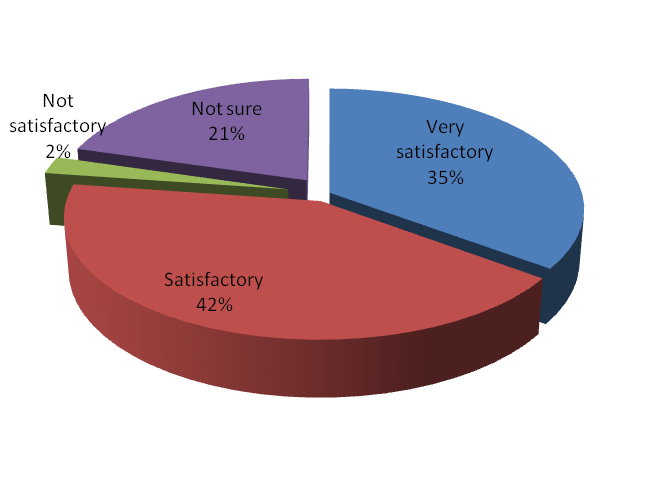 | Figure 4. Level of Satisfaction |
4.4. Likelihood of Another Visit or Invitation of Others
- As insinuated earlier on, the reasonable level of satisfaction derived from visit to Mole National Park influenced tourists’ response to inquiry on the likelihood of a repeat visit to the Park. With 69.8% indicating that they were likely to revisit the park, the satisfaction derived is further affirmed. Those who indicated “maybe” would no doubt include the percentage that was not sure of their level of satisfaction. As expected, only a very small percentage (2.3%) indicated that they were not likely to repeat their visit. Reasons for this could include the distance the tourist requires to make the journey which makes a repeat visit expensive. Rather, such tourist would prefer to visit another park that is closer to his origin, thereby reducing cost, and also diversify his experience with ecotourism. A huge 90.7% indicated that they would invite others to visit the Park. This figure is higher than those who intended to repeat their visit. The fact that some would not be able to come back has not prevented them from informing and inviting others to visit the park. This strongly affirms the earlier indicated high level of satisfaction derived by the tourists.
|
4.5. Reason for Probable Next Visit
- A revisit to Mole National Park has been hinged on certain reasons which included the serenity of the environment, the desire to see another animal (not seen at first visit), future research and coming in the company of friends (see Figure 5). It would be fun for a particular tourist to come in contact with some other wildlife which he was not able to see during his/her first visit and this has a great attraction to tourists (hence 63% respondents). This equally proves that the most fascinating experience comes from game (wildlife) viewing. This is usually the main attraction in wildlife parks all over the world. Therefore, the experience at Mole National Park is not an aberration. Future research has equally attracted some (21%) response which implies that those without such intentions at the initial visit would consider it as a reason for another visit. Serenity and visitation with friends attracted responses from just 9% and 7% of the tourists respectively. Such factors hardly drive tourist interest (when compared with wildlife attraction) in particular tourist attractions since there are several serene environments and friends could visit tourist centres on their own.
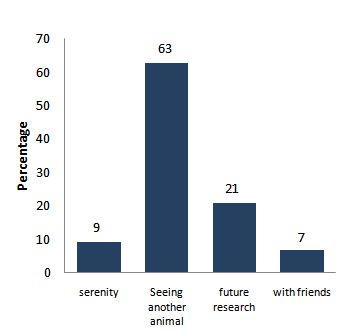 | Figure 5. Reasons for probable next visit |
5. Conclusions
- It is evident from the findings of this research that ecotourism attracts the younger generation of visitors. Since ecotourism activities at Mole National Park were found at least satisfactory by 77% of the visiting tourists, it is inferred that there would be need to sustain or raise the satisfaction level of the younger generation of tourists in order to improve patronage. The high level of satisfaction has equally influenced the decision by tourists to repeat their visit and invite other persons in order to enjoy game view and for future research. In order to sustain or improve such level of satisfaction, there would be need for Mole National Park management to sustain existing activities and equally introduce additional facilities and activities which are compatible with ecotourism. Specifically, the provision of more restrooms for visitors will improve tourist satisfaction. Furthermore, the provision of more safari vehicles makes accessibility to different ranges within the park easier while the completion of construction work on the access road to the park will encourage more tourists to patronise it.The need for more comfortable accommodation to support the intention to relax as indicated by tourists would be expedient in attracting tourists to the park. Games which the younger generation of tourists would find attractive should be made available at the motels in order to provide them with maximum fun and relaxation during their visit. Popular games like Table-tennis and snookers will be attractive to tourists. The government of Ghana would need to promote the park through improved advertisement and sensitization of citizens and foreigners. This would definitely improve the lot of ecotourism in Ghana and the West African sub-region in general.
 Abstract
Abstract Reference
Reference Full-Text PDF
Full-Text PDF Full-text HTML
Full-text HTML
